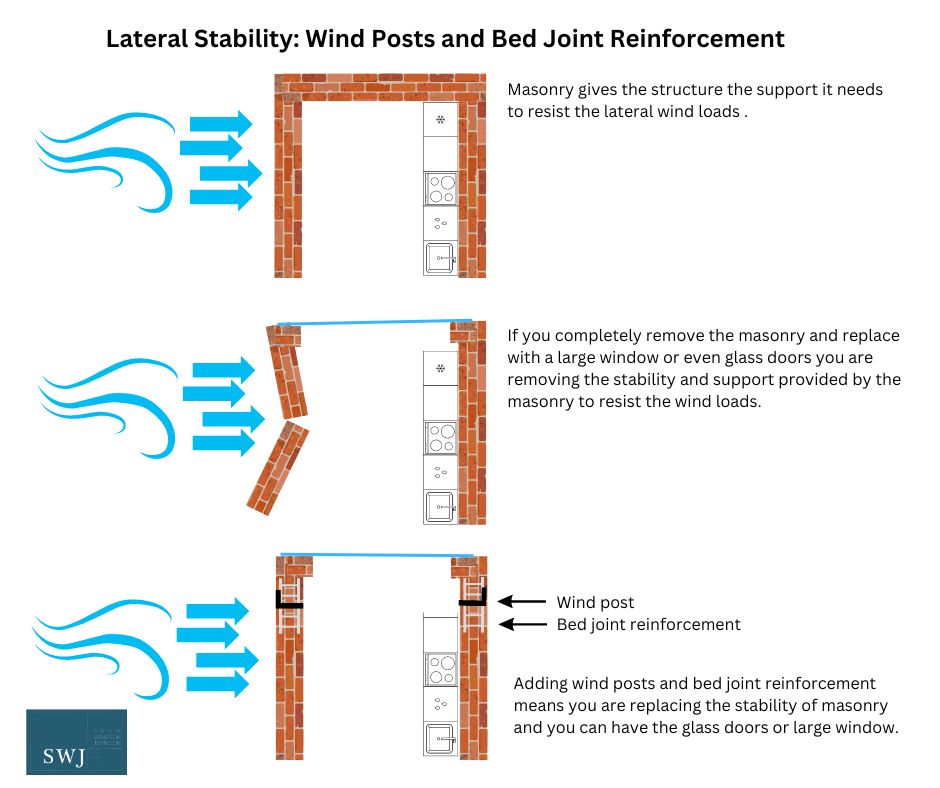We are asked about wind posts and their necessity in our designs all the time. This article explains why they are important and why we include them but also the steps we take to avoid the use of them – so our clients know we have done all we can to avoid their use.
Why are wind posts necessary?
Wind posts are primarily used to restrain lateral wall panels and protect against wind loads. The need for them is increasing as the trend for larger windows and bifold doors grows. When you replace masonry with an opening – you need to replace the support that masonry gave to your structure, with either wind posts or bed joint reinforcement, or both. This is true if you are designing a new build or making alterations to an existing building. Wind loads can vary depending on the building height, its orientation, geometry, and sheltering effects from surrounding structures, all of which need to be taken into consideration.
With developer-led housing we understand speed is of the essence. The need to add a wind post can slow down construction.
Wind posts can be fitted retrospectively but this involves cutting a wall to install the posts in the cavity, and then using wall ties to complete the job. It is a slow process and expensive as it requires a skilled construction professional which is why architects and clients want to avoid the need for them.
Avoiding the use of wind posts can sometimes be achieved by using a buttressing wall or bed joint reinforcement. Creating a buttress can sometimes be achieved with a tweak in internal floor layouts, like moving a door away from an external masonry load-bearing wall or a strengthened stud partition wall. If a buttress is not possible, or sufficient then bed joint reinforcement in new builds needs to be considered.
Bed joint reinforcement increases the overall strength and durability of a wall. By placing bed joint reinforcement in the mortar between each layer of bricks there is better distribution of loads and the potential for any cracking is reduced. It is commonly used in developer-led housing as a matter of course to reduce the risk of cracking due to movement. Because bed joint reinforcement is placed in the mortar between layers of blocks it can not be fitted retrospectively – it is not a suitable solution for alterations, only new builds, and extensions.
SWJ Consulting’s process to avoid wind posts where possible for developer-led housing
We have learned that the issue of wind posts and bed joint reinforcement is a common concern as the trend for larger windows and doors persists. Our process to avoid wind posts where possible evaluates a panel’s ability to resist lateral loads. We adopt the latest technology where we input the geometry of the panel, with any large openings, and the software runs the calculations to see if the panel is strong enough. If additional strength is required, we complete the following:
1. We complete our assessment on the panels without wind posts of bed joint reinforcement.
2. If that fails, we then add the bed joint reinforcement to our assessment
3. If that fails, we then look at designing that panel with a stronger concrete block
4. If adding all of the above fails, we would then add wind posts as a necessary last resort.
Every panel is different and the wind blows at different strengths from different directions. Your structure might be next to a tall tower block that increases the wind pressure on your buildings, or in an open field subject to gusts. This process ensures that we have done all we can, as structural engineers, to keep costs and timescales to a minimum. It is important to consult us as early as possible in the design stage to ensure that the architect’s vision is achievable and that elements, such as wind posts or bed joint reinforcements, are not overlooked at the crucial stage.
If you are concerned about wind posts in your projects or are looking to value engineer an existing design for developer-led housing, please do give us a call on 01993 225085 or email mail@swjconsulting.co.uk and we can take a look and talk you through your options.





